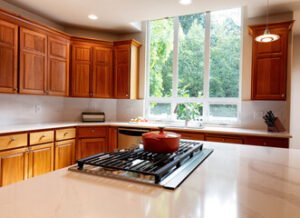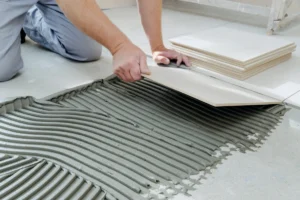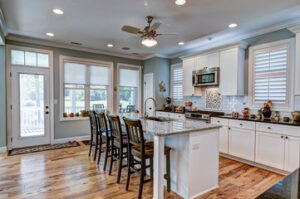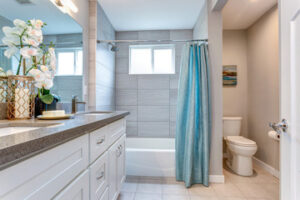Cabinet refacing keeps the existing cabinet boxes and interior frames, while changing their appearance by adding new doors and drawer fronts. Cabinet Refacing Sacramento can be more cost-effective than replacing cabinets.

Different refacing materials require tailored care to keep them looking their best. For example, solid wood refacing suits rustic and traditional designs, while PVC vinyl is ideal for contemporary styles.
Cabinet refacing gives your kitchen an overhaul, replacing existing cabinet doors and drawer fronts with new components to transform the overall appearance. A wide selection of styles and finishes are available to suit your taste. It’s ideal for homeowners who want to change the look of their cabinets without a major renovation or a costly investment.
The process begins with your contractor removing the old doors and hardware, cleaning and sanding the cabinet surface, and then applying a new finish. Your options include painting or staining. The refinishing process can take several days to a couple of weeks depending on the size of your kitchen and complexity of your chosen color. Using a high-quality stain or paint is important to ensure longevity and durability. It’s also a good idea to view color samples in your home under different lighting conditions to ensure you’ll be happy with the results.
One of the most popular options for refacing cabinets is wood veneer. It’s a durable material that offers natural beauty and warmth to your kitchen. It’s also a great option for those who are looking to maintain the original design of their kitchen. It’s important to keep in mind, however, that wood veneers require tailored maintenance to preserve their luster and functionality. For example, wood veneers can be maintained with a regular wiping down with mild cleanser or by occasionally polishing them. It’s also important to keep in mind that wood cabinets may require extra care to protect them from moisture and heat damage.
Another option for cabinet refacing is laminate or thermofoil. Laminate is a durable material that is easy to clean and offers an array of color and pattern options. While it’s not as versatile as solid wood, it’s a great choice for those who don’t have a particular style in mind or prefer a simple, clean look. While refacing with laminate or thermofoil is a more cost-effective solution, it doesn’t allow for significant changes to the design of your cabinets.
If you’re considering refacing your cabinets, your contractor will help you choose the best material for your project. Whether you’re looking for a subtle update or a dramatic transformation, they will work with you to select the style that fits your taste and budget.
Veneer or Laminate
When deciding to reface your cabinets, it’s important to consider the material you want to use. Laminate offers a cost-effective option and a variety of design possibilities while wood veneer gives the look of natural wood at a more premium price. Both can add a sophisticated appearance to your kitchen but differ in durability and maintenance needs.
Cabinet refacing uses existing cabinet boxes and doors while replacing their outer shell, resulting in less disruption to your daily routine. In addition to the aesthetic appeal, this type of renovation is more environmentally friendly than a full replacement as it reduces waste.
The refacing process begins by assessing the condition of your existing elements. If there are any damaged areas, you may need to repair them before applying the new surface. This is not an easy task and requires precise application of materials like glue to ensure a strong bond. If you decide to do this yourself, it is important to have a set of tools including a putty knife, hammer, and heat source such as a hairdryer or even a wrung out towel with hot water.
Once the damaged surfaces are repaired, your refacing contractor will clean and sand the surfaces to prepare them for the new finish. They will then apply the chosen material to the cabinets and trim the edges. During this step, the refacing material will be cut to size, and any excess is trimmed away with a utility knife.
If you chose to use laminate for your refacing project, it will be applied using an adhesive. Once the adhesive has been applied, it is pressed onto the existing cabinet boxes and doors. This ensures that the material is tightly adhered and will hold up to regular use.
Laminate is a popular choice because it provides a durable and low-maintenance solution with a wide range of designs. It’s also resistant to scratches and stains, making it ideal for busy kitchens. However, laminate can warp or chip if exposed to direct sunlight or water. It’s also not as good as real wood in terms of resale value, and some potential buyers will be turned off by the plastic-like appearance.
Rigid Thermofoil
Thermofoil, or Rigid Thermoformable Foils (RTF), is a versatile material that can be used for cabinet doors, drawer fronts, and accessories. It is made by heating a flexible vinyl layer and molding it to an MDF or particle board substrate. The result is a sturdy and durable surface that can be made to resemble painted or natural wood grain. Thermofoil cabinets offer several benefits that make them an attractive option for homeowners looking to update their kitchens or bathrooms on a budget.
Moisture Resistance
Thermoformable foils are moisture-resistant, making them ideal for kitchens, bathrooms, and laundry rooms. They will not warp or swell when exposed to moisture, which can be problematic for wood cabinets in high humidity environments. Additionally, rigid thermofoil is easy to clean and won’t stain or discolor over time. This low-maintenance feature is a major selling point for many homeowners, especially those who live with small children or pets.
Rigid thermofoil is also highly durable. It can withstand heavy foot traffic, impacts, and other environmental factors that can damage more delicate materials like wood. In addition, rigid thermofoil is available in a variety of colors and styles to match any aesthetic. This versatility makes it a popular choice for apartment refacing projects, as well as commercial applications like office spaces, restrooms, and trade show displays.
Although rigid thermofoil is a durable and practical option, it does have a few drawbacks that should be considered. The most significant issue is that it can melt or peel when exposed to heat, such as from a nearby stove. This is why it’s important to install rigid thermofoil cabinet doors at least five to six inches away from heat sources in the home.
Choosing the right material for your home is a personal decision that should be carefully weighed. Consider your budget, style preferences, and commitment to maintenance as you evaluate each option. Seek professional guidance if necessary to ensure that your choice aligns with your lifestyle and vision for your home.
Solid Wood
Solid wood cabinet refacing offers homeowners a natural, timeless look that adds a high level of sophistication to the kitchen. It is available in a range of styles and finishes, allowing homeowners to find a style that fits perfectly with their home’s decor. Additionally, solid wood cabinets are durable and can resist stains, scratches, and chips better than laminates.
In addition, refacing your cabinets in solid wood will help increase the value of your home. As a result, you will likely recoup more than 100% of the cost of refacing your cabinets if you ever decide to sell your home.
Although the initial upfront cost of refacing your cabinets in solid wood is more than that of laminate, the long-term benefits far outweigh this initial investment. Solid wood is durable and a more environmentally friendly material than laminates, which contain toxic chemicals. Additionally, solid wood is easy to repair, if needed, whereas laminate can crack or chip, making it difficult to fix.
Choosing a professional cabinet refacing company will ensure your project is done correctly and efficiently. A professional contractor will take accurate measurements, install the cabinets properly, and use safe tools for the job. Additionally, a cabinet refacing company will be able to guide you through the design process and provide valuable insights and recommendations that will help you achieve your dream kitchen.
The best way to find an affordable cabinet refacing contractor is to ask for referrals from friends and family members who have had their cabinets refaced recently. You can also check online reviews and look at a company’s portfolio or physical showroom to see if their work aligns with your vision for the perfect kitchen. Then, schedule a consultation and get an itemized estimate of the costs involved in your cabinet refacing project. This will give you a clear idea of the total costs for your refacing project so that you can plan accordingly and avoid any unexpected expenses. In addition, refacing your cabinets will reduce the amount of dust and downtime that is typically associated with installing new cabinetry in your home.


